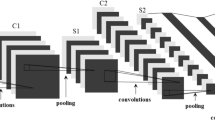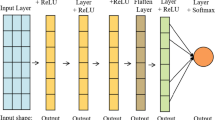Abstract
This paper presents an adaptive-slope squashing-function (ASF)-based artificial neural network (ANN) for efficient estimation of smoothly time-varying multipath fading channels, in a \(4 \times 1\) space-frequency-block-coded orthogonal-frequency-division-multiplexing (SFBC-OFDM) system using 64 subcarriers. The channel-state-information (CSI) estimated at first stage is further used for OFDM information symbol detection (through minimum mean square error criterion-based detection) at second stage. To combat the impact of smoothly time-varying environment, we emphasize on the utilization of ASF-ANN using backpropagation (BP) algorithm for the estimation of channel tap coefficients in frequency domain. The underlying ANN is modeled as feedforward multi-layered perceptron that updates the network weights. The major focus is on the gradient-descent algorithm-based adaptation of the slope of squashing-function (SF) along with other ANN parameters, which enhances the training efficiency of ASF-ANN in terms of the lower mean-squared channel estimation error in comparison with the traditional fixed-slope squashing-function (FSF) ANN technique. Simulation results corresponding to the underlying \(4 \times 1\) SFBC-OFDM system are presented to depict that ASF-ANN-based approach outperforms the FSF-ANN technique by providing lower bit-error-rate (BER) due to the usage of well-estimated CSI. At 15 dB SNR and fade rate = 0.001, the average BER reduces to \(2.85 \times 10^{ - 4}\) for the ASF-ANN based approach, due to improved CSI estimation, which accounts for approximately 5% improvement in the detection success rate as compared to the FSF-ANN-based approach.









Similar content being viewed by others
References
Cimini, L.J.: Analysis and simulation of a digital radio channel using orthogonal frequency division multiplexing. IEEE Trans. Commun. 33(7), 665–675 (1985)
Al-Dhahir, N.: Single-carrier frequency-domain equalization for space–time block-coded transmissions over frequency-selective fading channels. IEEE Commun. Lett. 5(7), 304–306 (2001)
Jang, J.-H.; Won, H.-C.; Im, G.-H.: Cyclic prefixed single carrier transmission with SFBC over mobile wireless channels. IEEE Signal Process. Lett. 13(5), 261–264 (2006)
Torabi, M.; Aissa, S.; Soleymani, M.R.: On the BER performance of space-frequency block coded OFDM systems in fading MIMO channels. IEEE Trans. Wirel. Commun. 6(4), 1366–1373 (2007)
Jemmali, A.; Torabi, M.; Conan, J.: Performance analysis of MIMO schemes in 3GPP long term evolution system. Wirel. Pers. Commun. 82(2), 1107–1125 (2015)
Ali, S.S.; Castanheira, D.; Alsohaily, A.; Sousa, E.S.; Silva, A.; Gameiro, A.: Joint space-frequency block codes and signal alignment for heterogeneous networks. IEEE Access 6, 71099–71109 (2018)
Du, Y.; Liu, J.; Chen, Y.: Performance analysis of nonlinear SFBC OFDM systems over TWDP fading channel. IEEE Access 7, 101981–101991 (2019)
Lee, K.F.; Williams, D.B.: Pilot-symbol-assisted channel estimation for space–time coded OFDM systems. EURASIP J. Adv. Signal Process. 2002(5), 374703 (2002)
Marzetta, T.L.: Noncooperative cellular wireless with unlimited numbers of base station antennas. IEEE Trans. Wirel. Commun. 9(11), 3590–3600 (2010)
Van de Beek, J.-J.; Edfors, O.; Sandell, M.; Wilson, S.K.; Borjesson, P.O.: On channel estimation in OFDM systems. In: Proceedings of the IEEE 45th Vehicular Technology Conference (VTC’95), Chicago, USA, vol. 2, pp. 815–819 (1995)
Edfors, O.; Sandell, M.; Van de Beek, J.-J.; Wilson, S.K.; Borjesson, P.O.: OFDM channel estimation by singular value decomposition. IEEE Trans. Commun. 46(7), 931–939 (1998)
Ma, X.; Kobayashi, H.; Schwartz, S.C.: An EM-based channel estimation algorithm for space–time and space–frequency block coded OFDM. In: Proceedings of the IEEE International Conference on Acoustics, Speech, and Signal Processing (ICASSP’03), Hong Kong, China, vol. 4, pp. IV-389–392 (2003)
Muruganathan, S.D.; Sesay, A.B.: A low-complexity decision-directed channel-estimation scheme for OFDM systems with space-frequency diversity in doubly selective fading channels. IEEE Trans. Veh. Technol. 58(8), 4277–4291 (2009)
Haykin, S.: Neural Networks and Learning Machines. Prentice-Hall, New Jersey (2009)
Zhou, X.; Wang, X.: Channel estimation for OFDM systems using adaptive radial basis function networks. IEEE Trans. Veh. Technol. 52(1), 48–59 (2003)
Seyman, M.N.; Taspinar, N.: Channel estimation based on neural network with feedback for MIMO OFDM mobile communication systems. Intell. Autom. Soft Comput. 18(3), 307–316 (2012)
Seyman, M.N.; Taspinar, N.: Channel estimation based on neural network in space time block coded MIMO–OFDM system. Digit. Signal Process. 23(1), 275–280 (2013)
Cui, T.; Tellambura, C.: Channel estimation for OFDM systems based on adaptive radial basis function networks. In: Proceedings of the IEEE 60th Vehicular Technology Conference (VTC’04), Los Angeles, USA, vol. 1, pp. 608–611 (2004)
Ye, H.; Li, G.Y.; Juang, B.: Power of deep learning for channel estimation and signal detection in OFDM systems. IEEE Wirel. Commun. Lett. 7(1), 114–117 (2018)
Kapoor, D.S.; Kohli, A.K.: Intelligence-based channel equalization for 4 × 1 SFBC-OFDM receiver. Intell. Autom. Soft Comput. 26(3), 439–446 (2020)
Gao, X.; Jin, S.; Wen, C.-K.; Li, G.Y.: ComNet: combination of deep learning and expert knowledge in OFDM receivers. IEEE Commun. Lett. 22(12), 2627–2630 (2018)
Zhang, J.; Wen, C.-K.; Jin, S.; Li, G.Y.: Artificial intelligence-aided receiver for a CP-free OFDM system: design, simulation, and experimental test. IEEE Access 7, 58901–58914 (2019)
Zhang, J.; Cao, Y.; Han, G.; Fu, X.: Deep neural network-based underwater OFDM receiver. IET Commun. 13(13), 1998–2002 (2019)
Burse, K.; Yadav, R.N.; Shrivastava, S.C.: Channel equalization using neural networks: a review. IEEE Trans. Syst. Man Cybern. Part C 40(3), 352–357 (2010)
Xu, S.; Zhang, M.: Justification of a neuron-adaptive activation function. In: Proceedings of the IEEE-INNS-ENNS International Joint Conference on Neural Networks (IJCNN’00), Como, Italy, vol. 3, pp. 465–470 (2000)
Liu, T.I.; Anantharaman, K.S.: On-line sensing of drill wear using neural network approach. In: Proceedings of the IEEE International Conference on Neural Networks (ICNN’93), San Francisco, USA, vol. 2, pp. 690–694 (1993)
Vecci, L.; Piazza, F.; Uncini, A.: Learning and approximation capabilities of adaptive spline activation function neural networks. Neural Netw. 11(2), 259–270 (1998)
Yu, C.-C.; Tang, Y.-C.; Liu, B.-D.: An adaptive activation function for multilayer feedforward neural networks. In: Proceedings of the IEEE Region 10 Conference on Computers, Communications, Control and Power Engineering (TENCOM’02), Beijing, China, vol. 1, pp. 645–650 (2002)
Thimm, G.; Moerland, P.; Fiesler, E.: The interchangeability of learning rate and gain in backpropagation neural networks. Neural Comput. 8(2), 451–460 (1996)
Zerdoumi, Z.; Chikouche, D.; Benatia, D.: Multilayer perceptron based equalizer with an improved back propagation algorithm for nonlinear channels. Int. J. Mob. Comput. Multimed. Commun. 7(3), 16–31 (2016)
Ratan, R.; Sharma, S.; Kohli, A.K.: Performance comparison of quadrature amplitude modulation (QAM)-based single- and double-stage digital interpolators. Int. J. Electron. 100(12), 1724–1734 (2013)
Jafarkhani, H.: A quasi-orthogonal space-time block code. IEEE Trans. Commun. 49(1), 1–4 (2001)
Kohli, A.K.; Kapoor, D.S.: Adaptive filtering techniques using cyclic prefix in OFDM systems for multipath fading channel prediction. Circuits Syst. Signal Process. 35(10), 3595–3618 (2016)
Kohli, A.K.; Mehra, D.K.: Tracking of time-varying channels using two-step LMS-type adaptive algorithm. IEEE Trans. Signal Process. 54(7), 2606–2615 (2006)
Rouquette, S.; Merigeault, S.; Gosse, K.: Orthogonal full diversity space-time block coding based on transmit channel state information for 4 Tx antennas. In: Proceedings of the IEEE International Conference on Communications (ICC’02), New York, USA, vol. 1, pp. 558–562 (2002)
Cho, Y.S.; Kim, J.; Yang, W.Y.; Kang, C.G.: MIMO-OFDM Wireless Communications with MATLAB®. Wiley, UK (2010)
Yang, B.; Letaief, K.B.; Cheng, R.S.; Cao, Z.: Channel estimation for OFDM transmission in multipath fading channels based on parametric channel modeling. IEEE Trans. Commun. 49(3), 467–479 (2001)
Morelli, M.; Sanguinetti, L.: Estimation of channel statistics for iterative detection of OFDM signals. IEEE Trans. Wirel. Commun. 4(4), 1360–1365 (2005)
Proakis, J.G.: Digital Communications, 3rd edn. McGraw-Hill, New York (1995)
Eraslan, E.; Daneshrad, B.; Lou, C.: Performance indicator for MIMO MMSE receivers in the presence of channel estimation error. IEEE Wirel. Commun. Lett. 2(2), 211–214 (2013)
Nawaz, S.J.; Mohsin, S.; Ikaram, A.A.: Neural network based MIMO-OFDM channel equalizer using comb-type pilot arrangement. In: Proceedings of the International Conference on Future Computer and Communication (ICFCC’09), Kuala Lumpar, Malaysia, pp. 36–41 (2009)
Chandra, P.; Singh, Y.: An activation function adapting training algorithm for sigmoidal feedforward networks. Neurocomputing 61(C), 429–437 (2004)
Rappaport, T.: Wireless Communications: Principles and Practice, 2nd edn. Prentice Hall, USA (2001)
Kohli, A.K.; Mehra, D.K.: Adaptive DFE multiuser receiver for CDMA systems using two-step LMS-type algorithm: an equalization approach. Wirel. Pers. Commun. 54(3), 543–558 (2010)
Kapoor, D.S.; Kohli, A.K.: Impact of squashing function’s slope on ANN based channel estimation in SFBC-OFDM system. In: Proceedings of the 12th International Conference on Computational Intelligence and Communication Networks (CICN’20), Bhimtal, India, pp. 258–260 (2020)
Chen, C.-T.; Chang, W.-D.: A feedforward neural network with function shape autotuning. Neural Netw. 9(4), 627–641 (1996)
Zerdoumi, Z.; Chicouche, D.; Benatia, D.: Neural networks based equalizer for signal restoration in digital communication channels. Int. Lett. Chem. Phys. Astron. 55, 187–200 (2015)
Kapoor, D.S.; Kohli, A.K.: Channel estimation and long-range prediction of fast fading channels for adaptive OFDM system. Int. J. Electron. 105(9), 1451–1466 (2018)
Sehrawat, S.; Kohli, A.K.: Optimized mitigation of impulsive noise in OFDM system using CSI. Optik 127(20), 9627–9634 (2016)
Author information
Authors and Affiliations
Corresponding author
Appendix
Appendix
1.1 Brief Details About LMMSE-Based Channel Estimation for SFBC-OFDM System
Let the received symbol vector in underlying SFBC-OFDM system be
(subscripts and indices in Eq. (4) are not shown for mathematical convenience).
As per conventional LS channel estimation method, the following cost function is minimized to provide optimum LS solution
where \({\hat{\mathbf{H}}}_{LS}\) is the LS estimated channel vector. However, the above function can also be rewritten as
In order to find the optimum value \({\hat{\mathbf{H}}}_{LS}\), for which the cost function in Eq. (35) gets minimized, the derivative of cost function with respect to the estimated channel vector needs to be calculated and equated to zero. It results in
where \((.)^{*}\) is the complex conjugation operator. The mathematical simplification of above equation leads to
This can also be expressed as
As the underlying system utilizes QO-codes, the matrix \({\mathbf{X}}^{H} {\mathbf{X}}\) is not purely diagonal, and therefore it contains some off-diagonal entries as well. Considering the LS estimate in (38), a better linear estimate in terms of weighted LS estimate can be applied by using the LMMSE channel estimation method, as suggested in [36]. This method finds a linear estimate to minimize the following error function
where \({\hat{\mathbf{H}}}_{MM} = {\mathbf{W}}_{MM} {\hat{\mathbf{H}}}_{LS}\) is the LMMSE estimate. As the estimation error \(\mathbf\psi\) is orthogonal to \({\hat{\mathbf{H}}}_{LS}\), therefore \(E\left[ {{\mathbf{\psi \hat{H}}}^{H}_{LS} } \right] = 0\). It follows that
where \({\mathbf{R}}_{{{\mathbf{H\hat{H}}}_{LS} }}\) is the cross-correlation matrix between true channel vector and LS estimated channel vector, and \({\mathbf{R}}_{{{\hat{\mathbf{H}}}_{LS} {\hat{\mathbf{H}}}_{LS} }}\) is the auto-correlation matrix of LS estimated channel vector. Further solution of Eq. (41) yields
Using Eq. (39), it can be shown that the auto-correlation matrix \({\mathbf{R}}_{{{\hat{\mathbf{H}}}_{LS} {\hat{\mathbf{H}}}_{LS} }}\) is
However, the cross-correlation matrix \({\mathbf{R}}_{{{\mathbf{H\hat{H}}}_{LS} }}\) is found to be
Subsequently, the LMMSE channel estimates using Eqs. (38), (42), (43) and (44) are expressed as
Rights and permissions
About this article
Cite this article
Kapoor, D.S., Kohli, A.K. Adaptive-Slope Squashing-Function-Based ANN for CSI Estimation and Symbol Detection in SFBC-OFDM System. Arab J Sci Eng 46, 9451–9464 (2021). https://doi.org/10.1007/s13369-020-05207-w
Received:
Accepted:
Published:
Issue Date:
DOI: https://doi.org/10.1007/s13369-020-05207-w




